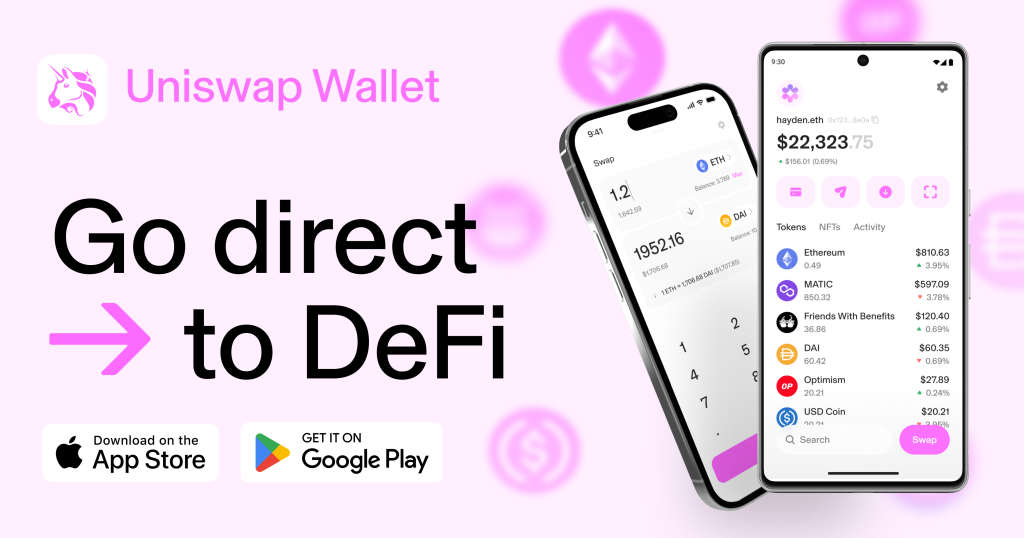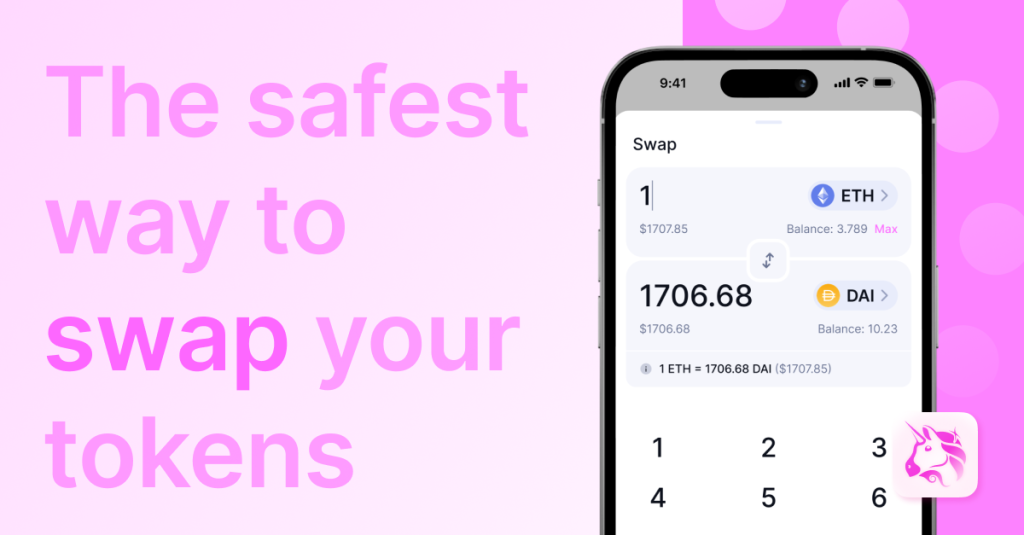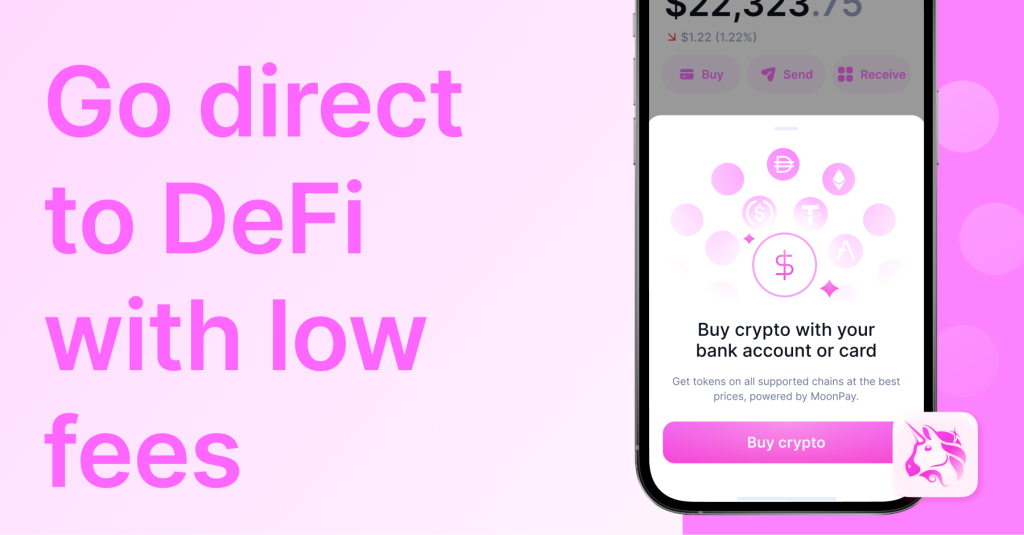
No, Uniswap is user-friendly and designed to be accessible for both beginners and experienced users.
User Interface and Experience
Navigating the Platform
Uniswap’s platform is designed to be user-friendly and accessible.
- Home Page: Easy access to swapping tokens, providing liquidity, and exploring pools.
- Swap Interface: Simple fields for selecting tokens and entering amounts, with adjustable slippage tolerance.
- Pool Section: Quick options for adding or removing liquidity, with clear information on total liquidity and user share.
- Analytics: View market data, trade volume, and liquidity trends.
Ease of Use for Beginners
Uniswap simplifies the trading experience for newcomers.
- Simple Setup: Requires an Ethereum-compatible wallet and ETH for gas fees. The platform guides users through the process.
- Educational Resources: Provides guides and tutorials to help users understand the platform.
- Tooltips and Help Sections: Explanations of key features and terms throughout the platform.
- Community Support: Forums, social media groups, and official channels offer assistance and troubleshooting.

Setting Up a Wallet
Compatible Wallets
To use Uniswap, you need an Ethereum-compatible wallet. Here are some of the most popular options:
- MetaMask: A widely used browser extension wallet that supports Ethereum and other ERC-20 tokens.
- Trust Wallet: A mobile wallet that offers support for multiple cryptocurrencies and is known for its user-friendly interface.
- Coinbase Wallet: A standalone app from Coinbase that allows users to manage their crypto and interact with decentralized applications.
- WalletConnect: A protocol that connects decentralized applications to mobile wallets using QR code scanning.
Connecting Your Wallet
Connecting your wallet to Uniswap is a straightforward process. Follow these steps to get started:
- Install the Wallet: Download and install a compatible wallet such as MetaMask, Trust Wallet, or Coinbase Wallet.
- Create or Import a Wallet: Set up a new wallet or import an existing one using your recovery phrase. Ensure your wallet has some ETH to cover transaction fees.
- Open Uniswap: Go to the official Uniswap website (app.uniswap.org) using a web browser.
- Connect Wallet: Click on the “Connect Wallet” button in the top right corner of the Uniswap interface.
- Choose Wallet Type: Select your wallet type (e.g., MetaMask, WalletConnect) from the list of options.
- Authorize Connection: Follow the prompts to authorize the connection between your wallet and Uniswap. This may involve approving the connection within your wallet app or extension.
- Start Trading: Once connected, you can start swapping tokens, providing liquidity, and exploring other features on Uniswap.
Making Trades
How to Swap Tokens
Swapping tokens on Uniswap is a straightforward process. Follow these steps to execute a trade:
- Open Uniswap: Navigate to the official Uniswap website (app.uniswap.org).
- Connect Your Wallet: Click on the “Connect Wallet” button and select your wallet type (e.g., MetaMask, Trust Wallet). Authorize the connection.
- Select Tokens: In the swap interface, choose the token you want to trade from and the token you want to trade to.
- Input Amount: Enter the amount of the token you wish to swap. The interface will automatically show the estimated amount of the target token you will receive.
- Review Trade Details: Check the details of your trade, including the exchange rate and the estimated amount you will receive.
- Adjust Slippage Tolerance: If necessary, adjust the slippage tolerance to account for potential price changes during the transaction.
- Confirm Swap: Click the “Swap” button and review the transaction details in your wallet. Confirm the transaction to execute the trade.
- Wait for Confirmation: Wait for the transaction to be processed and confirmed on the blockchain. You will receive a notification once the swap is complete.
Understanding Slippage
Slippage is the difference between the expected price of a trade and the actual price at which the trade is executed.
- Definition: Slippage occurs due to market volatility and changes in liquidity between the time a trade is submitted and when it is executed.
- Slippage Tolerance: This is a setting that allows you to specify the maximum acceptable slippage for your trade. If the slippage exceeds this threshold, the trade will not be executed.
- Adjusting Slippage Tolerance: In the swap interface, click on the settings icon and adjust the slippage tolerance percentage. A lower tolerance minimizes the price difference but increases the risk of the transaction failing.
- Minimizing Slippage:
- Trade During Low Volatility: Execute trades during periods of low market volatility to reduce slippage.
- Use Higher Liquidity Pools: Trade tokens with higher liquidity to ensure more stable prices and lower slippage.
- Split Large Trades: Consider breaking large trades into smaller ones to minimize their impact on the market price.

Providing Liquidity
Adding Liquidity
Providing liquidity on Uniswap allows you to earn a share of the trading fees. Here’s how to add liquidity to a pool:
- Connect Your Wallet: Open the Uniswap app (app.uniswap.org) and connect your Ethereum-compatible wallet (e.g., MetaMask, Trust Wallet).
- Navigate to Pool Section: Click on the “Pool” tab at the top of the interface.
- Select Add Liquidity: Click on the “Add Liquidity” button to begin the process.
- Choose Token Pair: Select the token pair you wish to provide liquidity for. Ensure you have equal values of both tokens in your wallet.
- Enter Amounts: Enter the amount of one token. The interface will automatically calculate the required amount of the other token.
- Review Details: Check the details, including your share of the pool and the potential earnings from trading fees.
- Approve Tokens: If this is your first time adding liquidity for this token pair, you’ll need to approve the tokens for use in the liquidity pool. Confirm the approval in your wallet.
- Supply Liquidity: Click “Supply” to add your tokens to the liquidity pool. Confirm the transaction in your wallet.
- Transaction Confirmation: Wait for the transaction to be confirmed on the blockchain. Once confirmed, you will see your liquidity position in the pool.
Removing Liquidity
You can remove your liquidity from a pool at any time to reclaim your tokens and earned fees. Here’s how to do it:
- Connect Your Wallet: Open the Uniswap app (app.uniswap.org) and connect your Ethereum-compatible wallet.
- Navigate to Pool Section: Click on the “Pool” tab at the top of the interface.
- Select Your Liquidity Position: Find and click on your liquidity position from the list of pools you have provided liquidity to.
- Click Remove: Click on the “Remove” button to start the process.
- Enter Removal Amount: Use the slider or input the percentage of liquidity you want to remove. The interface will show the amount of each token you will receive.
- Approve Transaction: If required, approve the transaction in your wallet.
- Confirm Removal: Click “Remove” and confirm the transaction in your wallet.
- Transaction Confirmation: Wait for the transaction to be processed and confirmed on the blockchain. Your tokens and earned fees will be returned to your wallet.

Fees and Costs
Trading Fees
- Standard Fee: Uniswap charges a 0.3% fee per trade, automatically deducted and distributed to liquidity providers.
- No Hidden Fees: Aside from the standard trading fee, there are no additional hidden fees.
Gas Fees
- Ethereum Gas Fees: Vary based on network congestion, measured in gwei. High during peak times.
- Optimizing Gas Costs: Trade during off-peak hours and adjust gas prices for savings, but note that lower prices may slow transaction times.
- Layer 2 Solutions: Use Optimism or Arbitrum for lower gas fees and faster transactions by processing off-chain and settling on Ethereum.
Common Issues and Solutions
Troubleshooting Connection Problems
If you encounter connection issues while using Uniswap, follow these steps to resolve them:
- Check Wallet Connection: Ensure your wallet (e.g., MetaMask, Trust Wallet) is properly connected to Uniswap. Disconnect and reconnect the wallet if needed.
- Browser Compatibility: Use a compatible browser like Chrome or Firefox. Clear your browser cache and cookies if you experience issues.
- Network Issues: Ensure you have a stable internet connection. Switching to a different network (e.g., from Wi-Fi to mobile data) may help.
- Update Wallet and Browser: Make sure both your wallet extension and browser are up-to-date.
- Disable Extensions: Other browser extensions may interfere with Uniswap. Try disabling them temporarily to see if the issue resolves.
Resolving Failed Transactions
Failed transactions can occur for various reasons. Here’s how to address them:
- Insufficient Gas Fees: Ensure you’ve set an adequate gas fee for your transaction. Increase the gas price to avoid underfunded transactions.
- Slippage Tolerance: Adjust your slippage tolerance settings in the Uniswap interface. Higher tolerance can prevent transaction failures due to price changes.
- Network Congestion: During high network congestion, transactions may fail. Wait for a less busy time to retry your transaction.
- Check Token Approval: Ensure you’ve approved the token for trading. You may need to approve the token first if it’s your initial transaction with it.
- Transaction Stuck Pending: If a transaction is stuck, you can speed it up by submitting another transaction with a higher gas fee. Alternatively, cancel the pending transaction if your wallet supports this feature.

Learning Resources
Uniswap Documentation
Uniswap provides comprehensive documentation to help users understand and navigate the platform effectively.
- Getting Started Guides: Step-by-step instructions for beginners on setting up wallets, connecting to Uniswap, and making trades.
- Detailed Articles: In-depth articles explaining key features such as liquidity pools, token swaps, and yield farming.
- API Reference: Technical documentation for developers looking to integrate with Uniswap or build on top of it.
- FAQs: Frequently asked questions covering common issues and their solutions, as well as general platform information.
Community Support and Tutorials
The Uniswap community offers a wealth of knowledge and support through various channels.
- Official Forums: Engage with other users and developers in the Uniswap community forums to ask questions, share experiences, and get help.
- Social Media Groups: Join Uniswap groups on platforms like Reddit, Telegram, and Discord for real-time support and discussion.
- YouTube Tutorials: Numerous YouTube channels provide video tutorials on using Uniswap, from basic operations to advanced strategies.
- Blog Posts and Articles: Read blog posts and articles from Uniswap’s official blog and other reputable sources for updates, tips, and insights.
- Interactive Courses: Some platforms offer structured courses and interactive tutorials on decentralized finance (DeFi) and using Uniswap effectively.